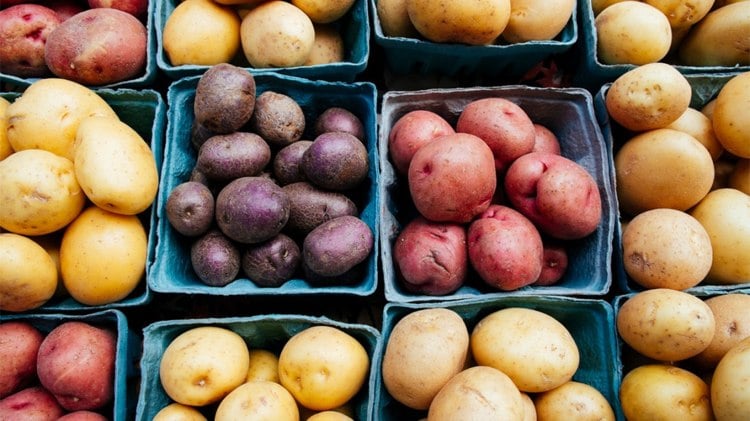Why do potatoes have a higher glycemic index than sugar?
Did you know that potatoes have a relatively high glycemic index (GI)? The GI indicates the extent to which certain foods cause blood sugar levels to rise. Each potato variety has a different index value, but for the majority it is between 80 and 90.
Why potatoes raise blood sugar

Potatoes are a staple food and appear in many German dishes. But people who pay attention to their blood sugar should eat it in moderation because potatoes, just like foods containing sugar, have a very high GI value. Why is that? The reason is quite simple: the starch in potatoes is converted into sugar in our body.
The starch in potatoes

Too often, glucose is associated with sweetness. White potatoes are usually not a food that is considered sweet. However, potatoes contain almost exclusively starch, and starch consists of long chains of glucose molecules.
Because the starch is quickly digested in potatoes, the glycemic index of potatoes can be almost as high as that of glucose alone. The glycemic index of glucose is 100 points, while the GI of potatoes usually varies between 80 and 90. However, potatoes have a higher GI value than table sugar. How is that possible?

Pure sucrose (table sugar) has a GI of 65 to 70. A sucrose molecule consists of a portion of glucose (glucose or dextrose) and fructose (fruit sugar). Fructose is processed differently in the body than glucose and does not affect blood sugar as much.
When you consider that 30 g of carbohydrates from potatoes contains twice as much glucose as sugar, it is only logical that they would have a higher impact on blood sugar levels than table sugar.
However, not all potatoes are created equal and there are ways to reduce their effects on your blood sugar. You can still enjoy potatoes from time to time, but in moderation.
Factors that affect potato GI

diversity
There are many types of potatoes and it would not be correct to say that each potato has a glycemic index of 80 or 90. In fact, researchers have found that the glycemic index can be as high as 53 for some potato varieties.
In a study, the researchers tested seven types of potatoes: Russet Burbank, Mayflower, Nicola, Bintje, Carisma, Desiree and Virginia Rose. They found that the Carisma potato had a GI of 53, making it the only one in the group to be classified as a low GI variety. With 69 GI, the Nicola fell into the medium GI category. Russet Burbank potatoes, which are very popular, ranked highest at 82 GI.

In general, the GI value of potatoes can be between 53 and 111, with white potatoes typically being rated lower in the index. If you do not peel the potatoes, you can reduce the effect on the glucose content. The sweet potato is often rated with a GI value of around 40.
Cooking method

The way you prepare your potatoes, including the cooking method and added ingredients, can affect the glycemic effect. A study published by the Journal of the American Dietetic Association examined how different cooking methods influence the glucose response of potatoes.
The researchers found that the way potatoes are prepared plays a big role. They advised consumers to pre-cook potatoes and eat them cold or reheated if they wanted to minimize the glycemic effects.
A finished instant mashed potato and boiled red potatoes triggered the highest glycemic response. Fried potatoes showed a slightly lower glycemic response.
Should You Eat Less Potatoes?

There are several factors to consider when deciding whether or not to include potatoes in your low GI diet.
Different people have different glycemic reactions to different foods. The most important factor is how your own body reacts to potatoes. You can get this information with a blood glucose meter. This is particularly important if your body does not process sugar optimally or you have been diagnosed with prediabetes. A high blood sugar level has consequences not only for diabetics and can cause serious problems.
It depends on the portion size

Potatoes provide the body with important nutritional values. A serving of potatoes is about 150 grams. The glycemic load (or glycemic response) depends on how much of it you eat and what other foods you eat with the potatoes. Most often, potatoes are eaten as a side dish rather than a main course, which changes the effects on your blood sugar.
For example, you should eat meat with a small potato and a salad so that the meal is balanced. The other foods can actually reduce the potato’s effect on your glucose.
The same goes for low GI foods like beans and lots of vegetables. If you combine potatoes with a lot of healthy fat, protein or fiber, the glucose effects are also reduced.

Conclusion
While potatoes can be high in glucose, think about what you can do to reduce it. If you want to eat potatoes, choose a potato variety with a lower GI, eat smaller portions, and combine potatoes with foods that counteract glucose. Above all, keep an eye on your blood sugar and watch how these changes affect you personally.

The post Why do potatoes have a higher glycemic index than sugar? appeared first on Deavita.com | Living ideas, design, hairstyles, make-up, lifestyle, health and beauty tips.





















